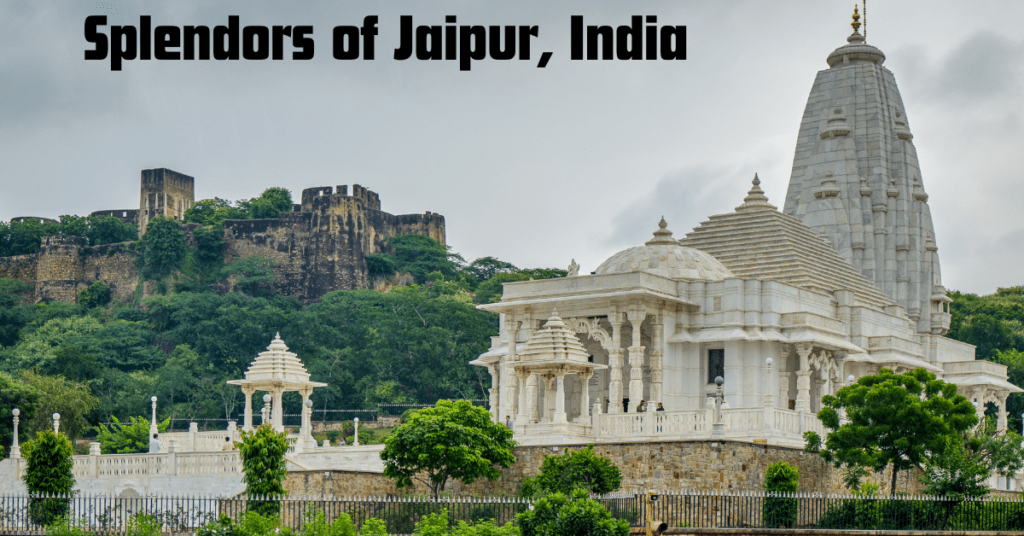Introduction:
Located in the northern state of Rajasthan,Exploring the Splendors of Jaipur: Unveiling the Pink City’s Riches Jaipur is a city that enthralls visitors with its rich cultural heritage and mesmerizing architecture. Known as the Pink City, this vibrant destination is a testament to the enduring influence of the mighty Maharajas of the past. Let us delve into the essence of Jaipur’s culture and heritage. They are exploring the origins of the Pink City and the treasures it holds.
The Essence of Jaipur’s Culture and Heritage:
Jaipur, the capital of Rajasthan, stands as a beacon of the state’s culture and heritage. The city is renowned for its architectural marvels, vibrant markets, and warm hospitality. Stepping into the narrow lanes and bustling bazaars is like taking a trip back in time. Immersing yourself in the glorious history of this land
The Origins of the Pink City:
The story behind Jaipur’s nickname, the Pink City, dates back to 1876. The city was painted pink to welcome the Prince of Wales, Albert Edward, stunning hue became synonymous with the city and remains its trademark to this day. The pink buildings were originally meant to mimic the sandstone structures of Mughal cities. Give Jaipur a distinctive and alluring appeal.
The Enduring Influence of Maharajas:
The monarchy of Rajasthan played a significant role in shaping the city of Jaipur. Maharaja Jai Singh II, the founder of Jaipur, was a visionary leader who integrated science and astrology into the city’s planning. Vidyadhar Bhattacharya is its architect.
The influence of the Maharajas is visible in the majestic palaces and forts that adorn the city’s landscape. The Amber Fort, perched atop a hill, is a stunning testament to the grandeur of a bygone era. Its intricate carvings, expansive courtyards, and stunning views captivate visitors, transporting them to a world of opulence and charm.
City Palace:
Another architectural gem is the City Palace, a complex of stunning palaces, gardens, and museums. This magnificent structure is a blend of Rajput and Mughal architectural styles. Showcasing the rich cultural fusion that defined Jaipur’s heritage The City Palace also houses the famous Peacock Gate, adorned with beautiful motifs and designs, and the fascinating Armoury Museum. Displaying a collection of weapons from the royal arsenal.
The vibrant markets of Jaipur are a true reflection of the city’s rich heritage. Johari Bazaar, famous for its jewelry; Bapu Bazaar, known for its textiles and handicrafts; and Nehru Bazaar, renowned for its blue pottery, is a shopaholic’s delight. Exploring these markets is an experience in itself, as you witness the skilled artisans at work, creating beautiful pieces of art that reflect the essence of Jaipur’s culture.
Jaipur, also known as the “Pink City” of India, is the capital of Rajasthan and a place where history, culture, and royal heritage come alive. Part of India’s Golden Triangle (alongside Delhi and Agra), Jaipur is renowned for its majestic palaces, vibrant markets, and architectural marvels, making it a dream destination for travelers. Here are some highlights:
- Amber Fort: Set on a hilltop with views of Maota Lake, Amber Fort is an iconic Rajput masterpiece. Its intricate architecture, courtyards, and mirror-adorned Sheesh Mahal (Hall of Mirrors) showcase the opulence of Rajasthan’s history. Visitors can also enjoy a traditional elephant ride up to the fort.
- City Palace: Located in the heart of Jaipur, the City Palace is a sprawling complex of courtyards, gardens, and palatial buildings that once served as the residence of Jaipur’s royal family. It features the Mubarak Mahal (a textiles museum) and the Chandra Mahal, which is still a private residence of the royal family.
- Hawa Mahal: The iconic “Palace of Winds” is one of Jaipur’s most photographed landmarks. Built for the royal women to observe street festivals unseen, its unique honeycomb facade with 953 small windows allows cool air to flow through, making it a perfect summer retreat.
- Jantar Mantar: A UNESCO World Heritage Site, Jantar Mantar is an astronomical observatory with the world’s largest stone sundial. Built by Maharaja Jai Singh II, the founder of Jaipur, it’s a remarkable display of early scientific ingenuity and continues to fascinate visitors with its precision.
- Nahargarh Fort: Overlooking Jaipur from the Aravalli Hills, Nahargarh Fort offers panoramic views of the city, especially at sunset. Originally built as a retreat, it became a fortification with intricate designs and scenic spots, making it a favorite among tourists and locals alike.
- Albert Hall Museum: Located in the Ram Niwas Garden, this museum houses an extensive collection of artifacts, including paintings, sculptures, and ancient artifacts. Its Indo-Saracenic architecture and exhibitions on Rajasthani culture make it a significant cultural attraction.
- Colorful Bazaars: Jaipur’s markets are a shopper’s paradise, with vibrant bazaars like Johari Bazaar (for jewelry), Bapu Bazaar (for textiles and handicrafts), and Tripolia Bazaar (for traditional wear and home decor). Visitors can explore and buy Rajasthani specialties like bandhani fabrics, block-printed textiles, and Jaipur’s famous blue pottery.
- Rajasthani Cuisine: Jaipur is known for its rich and flavorful cuisine. Dishes like dal baati churma, gatte ki sabzi, laal maas (spicy mutton curry), and kachoris are must-tries. Numerous traditional restaurants, such as Chokhi Dhani, offer an authentic dining experience complete with folk performances and Rajasthani decor.
- Folk Art and Festivals: Jaipur is a hub of Rajasthani folk music, dance, and art forms, with traditional performances often featured at local festivals. Festivals like Teej, Gangaur, and the Jaipur Literature Festival bring vibrant celebrations, processions, and cultural displays to the city.
- Royal Heritage Hotels: Jaipur’s rich history comes alive in its heritage hotels, including the opulent Rambagh Palace and the Samode Haveli. These former royal residences allow visitors to experience the grandeur of Rajput royalty, complete with luxurious hospitality.
Jaipur’s architectural splendor, rich traditions, and warm hospitality make it a standout destination. Its blend of regal palaces, bustling markets, and cultural vibrancy offers an immersive journey into the heart of India’s royal heritage.
In conclusion:
Jaipur is a majestic city that evokes a sense of awe and wonders in its visitors. From its pink-hued buildings to its grand palaces and bustling markets, the city’s cultural and heritage treasures are truly unparalleled. The enduring influence of the Maharajas is visible at every turn. Reminding us of the rich history and heritage that continue to shape Jaipur’s identity. A visit to the Pink City promises an unforgettable journey into the heart of Rajasthan’s vibrant culture and its past splendor. The top 10 UNESCO Creative Cities are here.


3 Comments
I always learn so much from your posts. This one was particularly insightful and well-written.
This post was a delightful read – informative, engaging, and well-structured.
Thank you for this enlightening read. It’s evident that you’ve done thorough research on the topic.